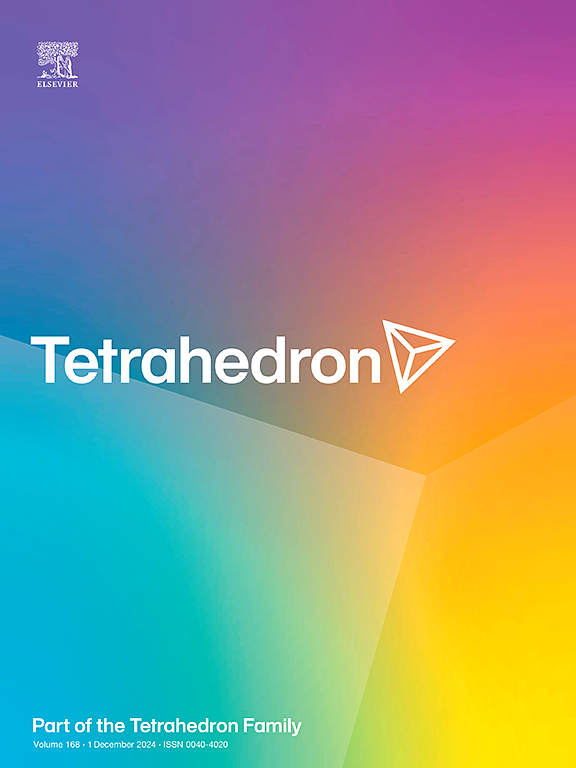Synthesis of rare−earth metal amido complexes with methyl substituted α-iminopyridine and their catalytic activities for hydroboration of nitriles
IF 2.2
3区 化学
Q2 CHEMISTRY, ORGANIC
引用次数: 0
Abstract
The reaction of [(Me3Si)2N]3RE(μ−Cl)Li(THF)3 with 6-CH3-2-[(CH3)2NCH2CH2NHCH2]C5H3N (1) or 5-CH3-2-[(CH3)2NCH2CH2NHCH2]C5H3N (2) resulted in the formation of rare−earth metal amido complexes bearing the dianionic α-iminopyridine {(μ-η2:σ1:κ1:κ1)(6-CH3-2-[(CH3)2NCH2CH2NCH]C5H3N)RE[N(SiMe3)2]}2 (RE = Y(3a), Sm(3b), Gd(3c), Er(3d), Pr(3e)) or {(μ-η2:σ1:κ1:κ1)(5-CH3-2-[(CH3)2NCH2CH2NCH]C5H3N)RE[N(SiMe3)2]}2 (RE = Y(4a), Sm(4b), Gd(4c), Er(4d)) through deprotonation and C–H bond activation of the 2-(aminomethylene)pyridine. These results indicated that the methyl substituent on the pyridine ring, whether at the 5- or 6-position, did not influence the deprotonation and C–H bond activation of 2-(aminomethylene)pyridine. Further investigation of the dianionic α-iminopyridine rare−earth metal amido complexes revealed that they exhibited exceptional catalytic activity for the hydroboration of nitriles with pinacolborane (HBpin). Especially, the catalytic process generated two types of completely different hydroboration products by controlling the different stoichiometric ratio of HBpin to nitriles.

甲基取代α-亚氨基吡啶稀土金属酰胺配合物的合成及其对腈硼氢化反应的催化活性
[(Me3Si)2N]3RE(μ−Cl)Li(THF)3与6-CH3-2-[(CH3)2NCH2CH2NHCH2]C5H3N(1)或5-CH3-2-[(CH3)2NCH2CH2NHCH2]C5H3N(2)反应生成稀土金属酰胺配合物,含重阴离子α-亚氨基吡啶{(μ-η2:σ1:κ1:κ1)(6-CH3-2-[(CH3)2NCH2CH2NCH]C5H3N)RE[N(SiMe3)2]}2 (RE = Y(3a), Sm(3b), Gd(3c), Er(3d), Pr(3e))或{(μ-η2:σ1:κ1)(5-CH3- [(CH3)2NCH2CH2NCH]C5H3N)RE[N(SiMe3)2]}2 (RE = Y(4a), Sm(4b), Gd(4c),Er(4d))通过去质子化和C-H键激活2-(氨基乙烯)吡啶。这些结果表明,吡啶环上的甲基取代基,无论是在5位还是6位,都不影响2-(氨基乙烯)吡啶的去质子化和C-H键的活化。对重阴离子型α-亚氨基吡啶稀土金属酰胺配合物的进一步研究表明,它们对腈与蒎烷硼烷(HBpin)的硼氢化反应具有特殊的催化活性。特别是,通过控制HBpin与腈的不同化学计量比,催化过程生成了两种完全不同的硼化氢产物。
本文章由计算机程序翻译,如有差异,请以英文原文为准。
求助全文
约1分钟内获得全文
求助全文
来源期刊

Tetrahedron
化学-有机化学
CiteScore
3.90
自引率
4.80%
发文量
439
审稿时长
34 days
期刊介绍:
Tetrahedron publishes full accounts of research having outstanding significance in the broad field of organic chemistry and its related disciplines, such as organic materials and bio-organic chemistry.
Regular papers in Tetrahedron are expected to represent detailed accounts of an original study having substantially greater scope and details than that found in a communication, as published in Tetrahedron Letters.
Tetrahedron also publishes thematic collections of papers as special issues and ''Reports'', commissioned in-depth reviews providing a comprehensive overview of a research area.
 求助内容:
求助内容: 应助结果提醒方式:
应助结果提醒方式:


